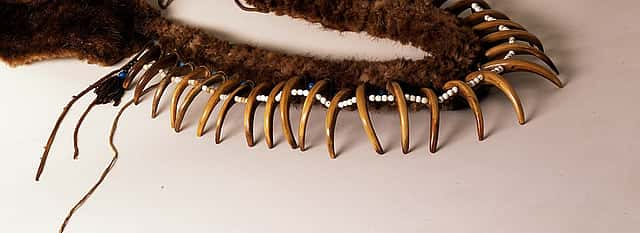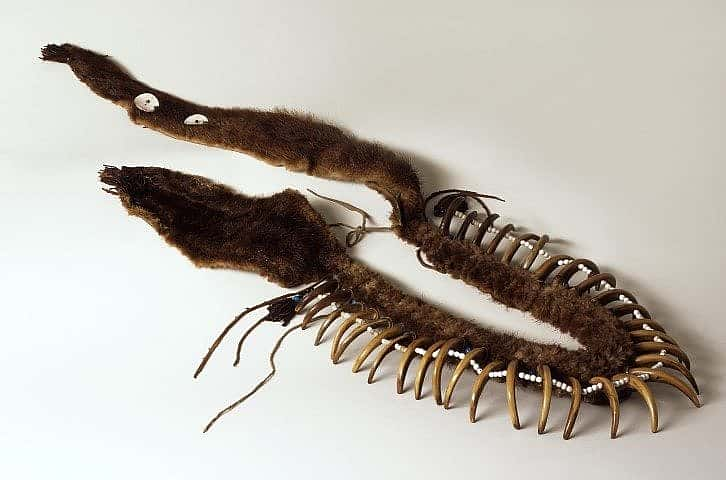
A Pawnee Bear Claw Necklace
Similar to the status symbolism of buffalo horn and eagle feather bonnets, bear claw necklaces were worn by distinguished Pawnee, Otoe, and Omaha men as emblems of their accomplishments, honors, and roles as leaders. Pawnee men, in particular, specialized in creating bear claw necklaces made from the long, broad claws of grizzly bears that once roamed the Central and Eastern Plains. On a Pawnee bear claw necklace which dates from around 1830, thirty-three claws—interspersed with white glass beads—are attached to a circle of otter hide that forms the base for the necklace. Abalone shells also decorate the tail of the otter, which would flow down the back of the wearer. While the claws represent the bear’s strength and courage, the otter hide signifies power over both land and water. Both animals’ qualities guided the wearer during warfare, treaty negotiations, and other important events.

The Pawnee, like other Plains Indian people, held grizzly bears in high esteem because of their strength, power, and fighting abilities—qualities universally admired by Native warriors. Before going into battle, Pawnee warriors sought the sacred protection of animal spirits such as wolves, eagles, mountain lions, or bears—each with their own unique powers. According to Pawnee cosmology, there are four great powers represented by the stars and constellation of the sky: wolf, mountain lion, wildcat (bobcat), and bear. Pawnee men believed that, in order to find success as warriors, they required the defining characteristics of these four animals: the stealth and craftiness of the wolf, the magnetic or drawing power of the mountain lion, the cunning of the cat, and the strength of the bear. In addition to its great strength, Pawnee warriors admired the bear for its ferocity and invulnerability. Through visions, spiritual teachings, and ceremonies, men could learn about and eventually possess the special powers of the bear, including the ability to heal wounds and cure sickness. Men believed that wearing the bear claw necklaces protected them from being hit by arrows and bullets in battle.*
*Excerpt from “Native Art and a Sense of Place in the Great Plains” by Emma I. Hansen, in Art of the American Frontier from the Buffalo Bill Center of the West, High Museum of Art and Yale University Press, 2013, 40 – 41.
Written By
Emma Hansen
Emma I. Hansen now serves as Curator Emerita and Senior Scholar after a 23-year career as Curator of the Plains Indian Museum. In that position, she directed the award-winning reinterpretation of the Plains Indian Museum and curated several exhibitions on Plains Indians arts and cultures. She has written numerous articles and conference papers ,and lectured at museums, universities, and other venues in the United States, Canada, and Great Britain. Publications include “Native Art and a Sense of Place in the Great Plains” in Art of the American Frontier: Art from the Buffalo Bill Center of the West, "The Art of Tipi Living” in Tipi: Heritage of the Great Plains, “Cultural Expressions of Plains Native Arts” in Splendid Heritage: Perspectives on American Indian Art, and her book, Memory and Vision: Arts, Cultures, and Lives of Plains Indian People.

